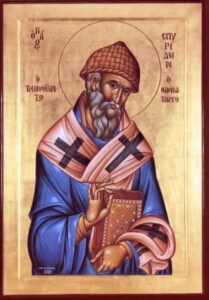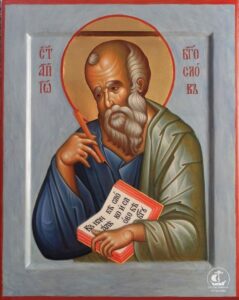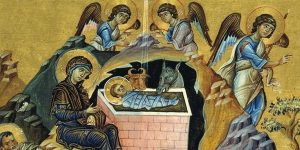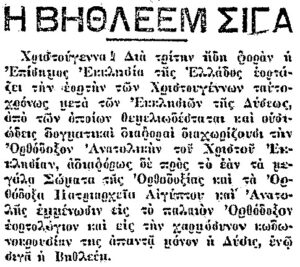Saint Winwaloe
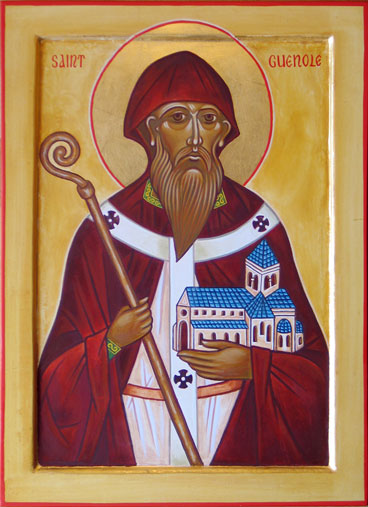
Fragan or Fracan, father of this saint, was nearly related to Cathoun, one the kings or princes of Wales, and had by his wife Gwen three sons, Guethenoc, Jacut, and Winwaloe, whom they bound themselves by vow to consecrate to God from his birth, because he was their third son. The invasions of the Saxons, and the storms which soon after overwhelmed his own country, obliged him to seek a harbour in which he might serve God in peace. Riwald had retired a little before with many others, from Wales into Armorica, and had been there kindly received; several Brittons, who had followed the tyrant Maximus, having settled in that country long before. Fragan therefore transported thither his whole family, about the middle of the fifth century, and fixed his habitation at a place called from him to this day, Plou-fragan, situated on the river Gouet, which ancient British and Gaulish word signifies blood. All accounts of our saint agree that his two elder brothers were born in Great Britain, but some place the birth of Saint Winwaloe, and of his sister Creirvie, much younger than him, in Armorica. The pious parents brought up their children in the fear of God, but out of fondness delayed to place Winwaloe in a monastery, till he was now grown up. At length, touched by God, the father conducted him to the monastery of Saint Budoc, in the isle of Laurels, now called Isleverte, or Green Island, not far from the isle of Brehat. Saint Budoc was an abbot in Great Britain, eminent for piety and learning, and flying from the swords of the Saxons, took refuge among his countrymen in Armorica, and in this little island assembled several monks, and opened a famous school for youth. Under his discipline, Winwaloe made such progress, that the holy abbot appointed him superior over eleven monks, whom he sent to lay the foundation of a new monastery. They traveled through Domnonea, or the northern coast of Brittany, and finding a desert island near the mouth of the river Aven, now called Chateaulin, they built themselves several little huts or cells. From these holy inhabitants the name of Tibidy, that is, House of Prayers, was given to that island, which it still retains. This place is exposed to so violent winds and storms, that after three years Saint Winwaloe and his community abandoned it, and built themselves a monastery on the continent, in a valley sheltered from the winds, called Landevenech, three leagues from Brest, on the opposite side of the bay. Grallo, count of Cornouailles, in which province this abbey is situated, in the diocese of Quimper-Corentin, gave the lands and was at the expense of the foundation of this famous monastery.
Saint Winwaloe, from the time he left his father’s house, never wore any other garments but what were made of the skins of goats, and under these, a hair shirt; day and night, winter and summer, his clothing was the same. In his monastery neither wheat-bread nor wine was used, but for the holy sacrifice of the liturgy. No other drink was allowed to the community but water, which was sometimes boiled with a small decoction of certain wild herbs. The monks eat only coarse barley-bread, boiled herbs, and roots, or barley-meal and herbs mixed, except on Saturdays and Sundays, on which they were allowed cheese and shell-fish, but of these the saint never tasted himself. His coarse barley-bread he always mingled with ashes, and their quantity he doubled in Lent, though even then it must have been very small, only to serve for mortification, and an emblem of penance. In Lent he took his refreshment only twice a week; his bed was composed of the rough bark of trees, or of sand, with a stone for his pillow. From the relaxation in the rule of abstinence on Saturdays, it is evident that this monastic rule, which was the same in substance with that received in other British, Scottish, and Irish monasteries, was chiefly borrowed from Oriental rules, Saturday being a fast-day according to the discipline of the Roman church. This rule was observed at Landevenech, till Lewis le Debonnaire, for the sake of uniformity, caused that of Saint Benedict to be introduced there in 818. Saint Winwaloe was sensible that the spirit of prayer, is the soul of a religious state and the comfort and support of all those who are engaged in it: as to himself, his prayer, either mental or vocal, was almost continual, and so fervent, that he seemed to forget that he lived in a mortal body. From twenty years of age till his death he never sat in the church, but always prayed either kneeling or standing unmoved, in the same posture, with his hands lifted up to heaven, and his whole exterior bespoke the profound veneration with which he was penetrated. He died on the 3rd of March, about the year 529, at a very advanced age. His body was buried in his own church, which he had built of wood, on the spot upon which the abbatial house now stands. These relics were translated into the new church when it was built, but during the ravages of the Normans they were removed to several places in France, and at length into Flanders. At present, the chief portions are preserved at Saint Peter’s, at Blandinberg, at Ghent, and at Montreuil in Lower Picardy, of which he is titular patron. In Picardy, he is commonly called Saint Vignevaley, and more commonly Walovay; in Brittany, Guignole, or more frequently Vennole; in other parts of France, Guingalois; in England Winwaloe or Winwaloc. His name occurs in the English litany of the seventh age, published by Mabillon.
His father, Saint Fracan, is titular saint of a parish in the diocese of Saint Brienc, called Plou-Fragan, of which he is said to have been lord, and of another in the diocese of Leon, called Saint Frogan; also, Saint Gwen his mother, of one in the same diocese called Ploe-Gwen, and of another in that of Quimper. In France, she is usually called Saint Blanche, the British word Gwen signifying Blanche or White. His brothers are honoured in Brittany, Saint Guethenoc, on the 5th of November, and Saint Jacut, or James, on the 8th of February and the 3rd of March; the latter is the patron of the abbey of Saint Jagu, in the diocese of Dol. Saint Balay, or Valay, chief patron of the parish of Plou-balai, in the diocese of Saint Malo, and a Saint Martin are styled disciples of Saint Winwaloe, and before their monastic profession were lords of Rosmeur, and Ros-madeuc. Some other disciples of our saint are placed in the calendars of several churches in Brittany, as Saint Guenhael his successor, Saint Idunet or Yonnet, Saint Dei, etc. See the ancient life of Saint Winwaloe, the first of the three given by Bollandus and Henschenius; that in Surius and Cressy not being genuine.

